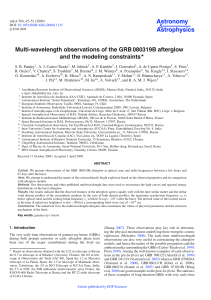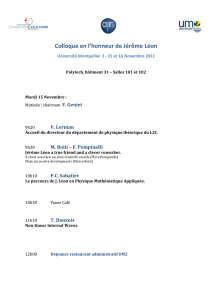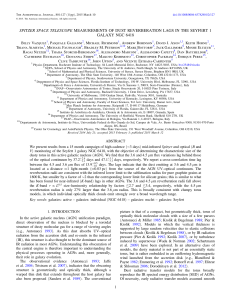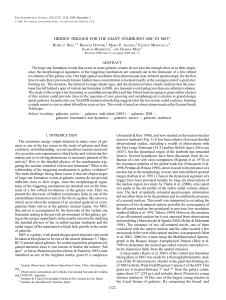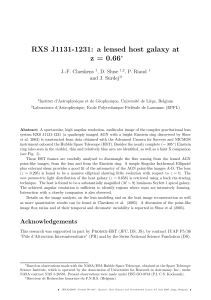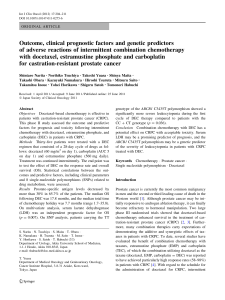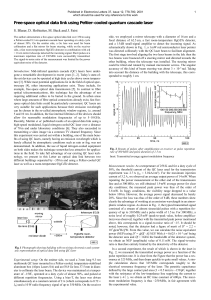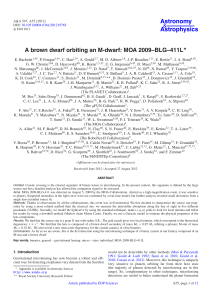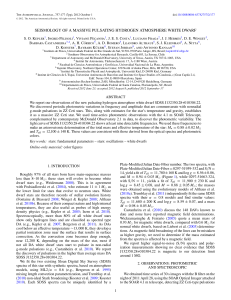186501.pdf
publicité
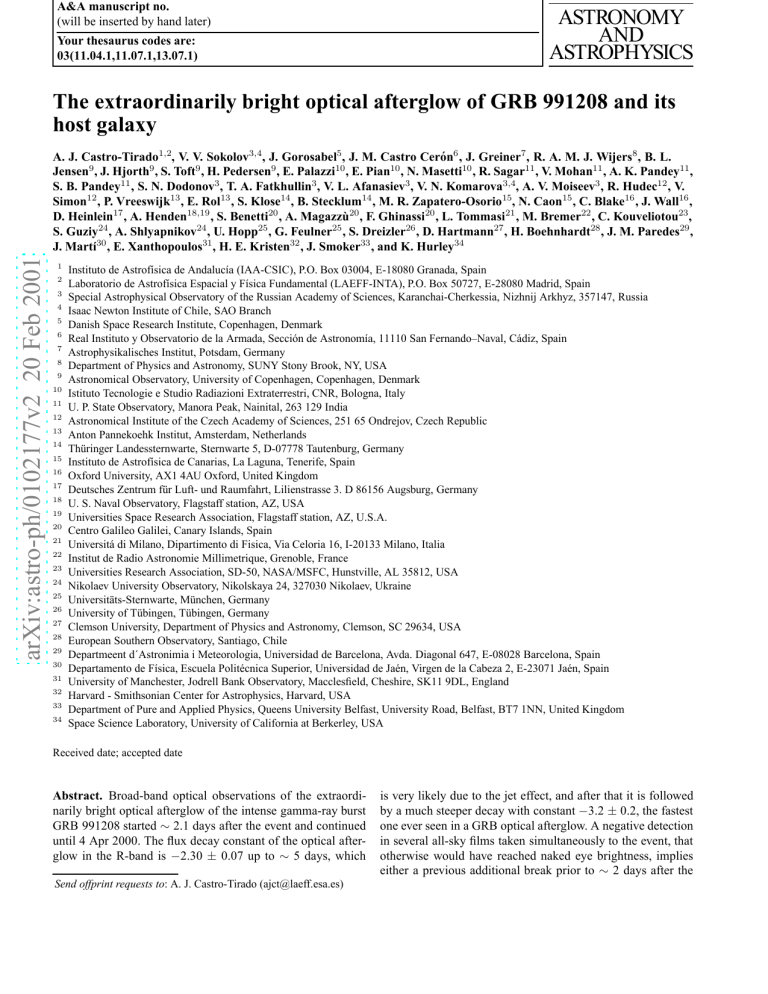
A&A manuscript no. (will be inserted by hand later) Your thesaurus codes are: 03(11.04.1,11.07.1,13.07.1) ASTRONOMY AND ASTROPHYSICS The extraordinarily bright optical afterglow of GRB 991208 and its host galaxy arXiv:astro-ph/0102177v2 20 Feb 2001 A. J. Castro-Tirado1,2, V. V. Sokolov3,4 , J. Gorosabel5, J. M. Castro Cerón6 , J. Greiner7 , R. A. M. J. Wijers8 , B. L. Jensen9 , J. Hjorth9 , S. Toft9 , H. Pedersen9 , E. Palazzi10 , E. Pian10 , N. Masetti10 , R. Sagar11 , V. Mohan11 , A. K. Pandey11 , S. B. Pandey11 , S. N. Dodonov3 , T. A. Fatkhullin3 , V. L. Afanasiev3, V. N. Komarova3,4, A. V. Moiseev3 , R. Hudec12 , V. Simon12 , P. Vreeswijk13 , E. Rol13 , S. Klose14 , B. Stecklum14 , M. R. Zapatero-Osorio15, N. Caon15 , C. Blake16 , J. Wall16 , D. Heinlein17 , A. Henden18,19 , S. Benetti20 , A. Magazzù20 , F. Ghinassi20 , L. Tommasi21 , M. Bremer22 , C. Kouveliotou23, S. Guziy24 , A. Shlyapnikov24 , U. Hopp25 , G. Feulner25 , S. Dreizler26 , D. Hartmann27 , H. Boehnhardt28 , J. M. Paredes29 , J. Martı́30 , E. Xanthopoulos31, H. E. Kristen32 , J. Smoker33 , and K. Hurley34 1 2 3 4 5 6 7 8 9 10 11 12 13 14 15 16 17 18 19 20 21 22 23 24 25 26 27 28 29 30 31 32 33 34 Instituto de Astrofı́sica de Andalucı́a (IAA-CSIC), P.O. Box 03004, E-18080 Granada, Spain Laboratorio de Astrofı́sica Espacial y Fı́sica Fundamental (LAEFF-INTA), P.O. Box 50727, E-28080 Madrid, Spain Special Astrophysical Observatory of the Russian Academy of Sciences, Karanchai-Cherkessia, Nizhnij Arkhyz, 357147, Russia Isaac Newton Institute of Chile, SAO Branch Danish Space Research Institute, Copenhagen, Denmark Real Instituto y Observatorio de la Armada, Sección de Astronomı́a, 11110 San Fernando–Naval, Cádiz, Spain Astrophysikalisches Institut, Potsdam, Germany Department of Physics and Astronomy, SUNY Stony Brook, NY, USA Astronomical Observatory, University of Copenhagen, Copenhagen, Denmark Istituto Tecnologie e Studio Radiazioni Extraterrestri, CNR, Bologna, Italy U. P. State Observatory, Manora Peak, Nainital, 263 129 India Astronomical Institute of the Czech Academy of Sciences, 251 65 Ondrejov, Czech Republic Anton Pannekoehk Institut, Amsterdam, Netherlands Thüringer Landessternwarte, Sternwarte 5, D-07778 Tautenburg, Germany Instituto de Astrofı́sica de Canarias, La Laguna, Tenerife, Spain Oxford University, AX1 4AU Oxford, United Kingdom Deutsches Zentrum für Luft- und Raumfahrt, Lilienstrasse 3. D 86156 Augsburg, Germany U. S. Naval Observatory, Flagstaff station, AZ, USA Universities Space Research Association, Flagstaff station, AZ, U.S.A. Centro Galileo Galilei, Canary Islands, Spain Universitá di Milano, Dipartimento di Fisica, Via Celoria 16, I-20133 Milano, Italia Institut de Radio Astronomie Millimetrique, Grenoble, France Universities Research Association, SD-50, NASA/MSFC, Hunstville, AL 35812, USA Nikolaev University Observatory, Nikolskaya 24, 327030 Nikolaev, Ukraine Universitäts-Sternwarte, München, Germany University of Tübingen, Tübingen, Germany Clemson University, Department of Physics and Astronomy, Clemson, SC 29634, USA European Southern Observatory, Santiago, Chile Departmeent d´Astronimia i Meteorologia, Universidad de Barcelona, Avda. Diagonal 647, E-08028 Barcelona, Spain Departamento de Fı́sica, Escuela Politécnica Superior, Universidad de Jaén, Virgen de la Cabeza 2, E-23071 Jaén, Spain University of Manchester, Jodrell Bank Observatory, Macclesfield, Cheshire, SK11 9DL, England Harvard - Smithsonian Center for Astrophysics, Harvard, USA Department of Pure and Applied Physics, Queens University Belfast, University Road, Belfast, BT7 1NN, United Kingdom Space Science Laboratory, University of California at Berkerley, USA Received date; accepted date Abstract. Broad-band optical observations of the extraordinarily bright optical afterglow of the intense gamma-ray burst GRB 991208 started ∼ 2.1 days after the event and continued until 4 Apr 2000. The flux decay constant of the optical afterglow in the R-band is −2.30 ± 0.07 up to ∼ 5 days, which Send offprint requests to: A. J. Castro-Tirado ([email protected]) is very likely due to the jet effect, and after that it is followed by a much steeper decay with constant −3.2 ± 0.2, the fastest one ever seen in a GRB optical afterglow. A negative detection in several all-sky films taken simultaneously to the event, that otherwise would have reached naked eye brightness, implies either a previous additional break prior to ∼ 2 days after the 2 A. J. Castro-Tirado et al.:The extraordinarily bright optical afterglow of GRB 991208. occurrence of the GRB (as expected from the jet effect) or a maximum as observed in GRB 970508. The existence of a second break might indicate a steepening in the electron spectrum or the superposition of two events, resembling GRB 000301C. Once the afterglow emission vanished, contribution of a bright underlying supernova is found on the basis of the late-time Rband measurements, but the light curve is not sufficiently well sampled to rule out a dust echo explanation. Our redshift determination of z = 0.706 indicates that GRB 991208 is at 3.7 Gpc (for H0 = 60 km s−1 Mpc−1 , Ω0 = 1 and Λ0 = 0), implying an isotropic energy release of 1.15×1053 erg which may be relaxed by beaming by a factor > 102 . Precise astrometry indicates that the GRB coincides within 0.2′′ with the host galaxy, thus given support to a massive star origin. The absolute magnitude of the galaxy is MB = −18.2, well below the knee of the galaxy luminosity function and we derive a star-forming rate of (11.5 ± 7.1) M⊙ yr−1 , which is much larger than the present-day rate in our Galaxy. The quasi-simultaneous broadband photometric spectral energy distribution of the afterglow is determined ∼ 3.5 day after the burst (Dec 12.0) implying a cooling frequency νc below the optical band, i.e. supporting a jet model with p = −2.30 as the index of the power-law electron distribution. ing rates) and to determine the energetics of the bursts (redshifts) and offsets with respect to the galaxy centres. About 25 hosts galaxies have been detected so far, with redshifts z in the range 0.43-4.50 and star-forming rates in the range 0.5-60 M⊙ year−1 . See Klose (2000), Castro-Tirado (2001) and references therein. Here we report on the detection of the optical afterglow from GRB 991208 as well as its host galaxy. This GRB was detected at 04:36 universal time (UT) on 8 Dec 1999, with the Ulysses GRB detector, the Russian GRB Experiment (KONUS) on the Wind spacecraft and the Near Earth Asteroid Rendezvous (NEAR) detectors (Hurley et al. 2000) as an extremely intense, 60 s long GRB with a fluence > 25 keV of 10−4 erg cm−2 and considerable flux above 100 keV. Radio observations taken on 1999 December 10.92 UT with the Very Large Array (VLA) at 4.86 GHz and 8.46 GHz indicated the presence of a compact source which became a strong candidate for the radio afterglow from GRB 991208 (Frail et al. 1999). 2. Observations and data reduction We have obtained optical images centered on the GRB location starting 2.1 days after the burst (Table 1). Photometric observations were conducted with the 1.04-m Sampurnanand Key words: Gamma rays: bursts - Galaxies: general - Cosmo- telescope at Uttar Pradesh State Observatory, Nainital, India logy: observations (1.0 UPSO); the 1.2-m Schmidt telescope at Tautenburg, Germany (1.2 TBG); the 1.5-m telescope at Observatorio de Sierra Nevada (1.5 OSN), Granada, Spain; the 2.5-m Isaac Newton Telescope (2.5 INT), the 2.56-m Nordic Optical Telescope (NOT), the 3.5-m Telescopio Nazionale Galileo (3.5 TNG) and the 4.21. Introduction m William Herschel Telescope (4.2 WHT) at Observatorio del Roque de los Muchachos, La Palma, Spain; the 1.23-m, 2.2-m Gamma–ray bursts (GRBs) are flashes of cosmic high energy and 3.5-m telescopes at the German-Spanish Calar Alto Obser(∼ 1 keV–10 GeV) photons (Fishman and Meegan 1995). For vatory (1.2, 2.2 and 3.5 CAHA respectively), Spain; the 3.5many years they remained without any satisfactory explana- m telescope operated by the Universities of Wisconsin, Indition since their discovery in 1967, but with the advent of the ana, Yale and the National Optical Astronomical Observatories Italian–Dutch X–ray satellite BeppoSAX, it became possible (3.5-m WIYN) at Kitt Peak, USA; and the 6.0-m telescope at to conduct deep counterpart searches only a few hours after the Special Astrophisical Observatory of the Russian Academy a burst was detected. This led to the first detection of X-ray of Sciences in Nizhnij Arhyz, Russia. and optical afterglow for GRB 970228 (Costa et al. 1997, van For the optical images, photometry was performed by means Paradijs et al. 1997) and the determination of the cosmological of SExtractor (Bertin and Arnouts 1996), making use of the distance scale for the bursts on the basis of the first spectrosco- corrected isophotal magnitude, which is appropriate for starpic measurements taken for GRB 970508, implying z ≥ 0.835 like objects. The DAOPHOT (Stetson 1987) profile-fitting tech(Metzger et al. 1997). nique was used for the magnitude determination on the later Subsequent observations in 1997-2000 have shown that a- epoch images, when the source is much fainter. Zeropoints, bout a third of the well localized GRBs can be associated with atmospheric extinction and color terms were computed using optical emission that gradually fades away over weeks to months. observations of standard fields taken throughout the run. MagNow it is widely accepted that long duration GRBs originate at nitudes of the secondary standards in the GRB fields agree, cosmological distances with energy releases of 1051 –1053 ergs. within the uncertainties, with those given in Henden (2000). The observed afterglow satisfies the predictions of the ”stan- Zeropoint uncertainties are also included in the given errors. dard” relativistic fireball model, and the central engines that Prompt follow up spectroscopy of the OA was attempted at power these extraordinary events are thought to be the collapse several telescopes (Table 2), but we only got a reasonable good of massive stars (see Piran (1999) and van Paradijs et al. (2000) signal-to-noise ratio (S/N) at the 6-m telescope SAO RAS usfor a review). ing an integral field spectrograph MPFS (Dodonov et al. 1999a). The detection of GRB host galaxies is most essential in or- One 2700-sec spectrum and one 4500-sec spectrum were obder to understand the nature of hosts (morphology, star form- tained on 13 and 14 Dec 1999 UT. On the latter, the observing 3 Table 1. Journal of the GRB 991208 optical/NIR observations Date of 1999 (UT) Telescope Filter Integration time (s) Magnitude 10.2708 Dec 10.2917 Dec 11.2111 Dec 11.2111 Dec 11.2507 Dec 11.2792 Dec 11.2833 Dec 12.0208 Dec 12.2000 Dec 12.2056 Dec 12.2181 Dec 12.2229 Dec 12.2299 Dec 12.2500 Dec 12.2535 Dec 12.2576 Dec 12.2604 Dec 12.2694 Dec 12.2757 Dec 12.2792 Dec 12.2806 Dec 12.2840 Dec 12.2882 Dec 13.0000 Dec 13.2604 Dec 13.2715 Dec 13.2729 Dec 13.2764 Dec 13.2799 Dec 13.2833 Dec 13.2910 Dec 14.2708 Dec 14.2743 Dec 14.2778 Dec 14.2792 Dec 14.2847 Dec 14.2875 Dec 15.2708 Dec 15.2833 Dec 15.2938 Dec 03.5319 Jan 03.5507 Jan 04.2292 Jan 05.2292 Jan 06.2083 Jan 13.2097 Jan 13.2528 Jan 19.2604 Jan 29.2431 Jan 29.2604 Jan 13.2556 Feb 17.2882 Feb 31.8403 Mar 31.8715 Mar 31.9028 Mar 31.9583 Mar 04.2083 Apr 11.2708 Feb 2.5 NOT 2.5 INT 1.3 TBG 2.2 CAHA 2.2 CAHA 2.5 INT 2.5 INT 1.0 UPSO 1.2 CAHA 1.2 CAHA 1.2 CAHA 1.2 CAHA 1.2 CAHA 1.5 OSN 1.2 CAHA 1.5 OSN 2.5 NOT 2.5 NOT 2.5 INT 2.5 NOT 2.5 INT 2.5 INT 3.5 TNG 1.0 UPSO 2.5 NOT 2.5 INT 2.5 NOT 2.5 INT 2.5 INT 2.5 NOT 3.5 TNG 2.5 NOT 2.5 INT 2.5 INT 2.5 NOT 3.5 TNG 2.5 NOT 2.5 NOT 2.5 NOT 2.5 NOT 3.5 WIYN 3.5 WIYN 2.2 CAHA 3.5 CAHA 2.2 CAHA 3.5 CAHA 3.5 CAHA 2.5 NOT 4.2 WHT 4.2 WHT 3.5 TNG 3.5 TNG 6.0 SAO 6.0 SAO 6.0 SAO 6.0 SAO 2.5 NOT 3.5 TNG R I I R R R I I B V R V B R U I R I B V V I R I R B I V I V R R B U I R V R I V R I R R V R V R I B B V V I B R I J 300 240 900 600 600 300 300 2 x 200 300 300 300 500 500 2 x 600 6 x 500 300 3 x 300 3 x 300 500 300 300 180 500 3 x 600 3 x 300 500 3 x 300 180 300 300 360 3 x 300 1,000 535 3 x 300 600 300 3 x 300 3 x 300 2 x 300 600 600 2 x 900 2 x 1,200 9 x 1,200 3 x 1,200 2 x 1,200 7 x 600 2 x 900 986 3 x 1,200 2 x 1,200 1,490 360 1,795 1,260 3,800 42 x 60 18.7 ± 0.1 > 15.5 18.75 ± 0.11 19.60 ± 0.03 19.61 ± 0.04 19.70 ± 0.08 19.2 ± 0.1 19.9 ± 0.3 > 20.3 > 20.5 20.0 ± 0.3 20.7 ± 0.4 21.3 ± 0.2 19.9 ± 0.5 > 19.8 19.8 ± 0.5 20.37 ± 0.05 19.95 ± 0.05 21.40 ± 0.05 20.85 ± 0.05 20.78 ± 0.06 20.00 ± 0.17 20.0 ± 0.3 20.3 ± 0.2 20.89 ± 0.04 22.03 ± 0.06 20.34 ± 0.06 21.36 ± 0.07 20.26 ± 0.11 21.38 ± 0.07 20.8 ± 0.3 21.43 ± 0.04 22.31 ± 0.08 > 23.0 20.91 ± 0.07 21.40 ± 0.10 21.68 ± 0.10 21.97 ± 0.08 21.46 ± 0.16 >21.8 > 23.0 > 22.0 > 23.5 23.23 ± 0.13 23.83 ± 0.10 > 23.1 > 22.5 23.65 ± 0.13 > 22.5 > 23.6 24.65 ± 0.04 24.22 ± 0.09 24.55 ± 0.16 23.46 ± 0.49 25.19 ± 0.17 24.27 ± 0.15 23.3 ± 0.2 > 22.0 ′′ conditions were good: the seeing was ∼ 1.5 (at a zenithal distance of 60◦ ), and there was good transparency. We used 300 lines/mm grating blazed at 6000 Å giving a spectral resolution of about 5 Å/pixel and effective wavelength coverage of 4100 - 9200 Å. The spectrophotometric standards HZ44 and BD+75◦ 325 (Oke et al. 1995) were used for the flux calibration. Table 2. Journal of the GRB 991208 spectroscopic observations Date of 1999 (UT) Telescope Wavelength range (A) Exposure time (s) 12.2306 Dec 12.2347 Dec 13.2083 Dec 14.2083 Dec 18.2431 Dec 2.2 CAHA 3.5 CAHA 6.0 SAO 6.0 SAO 4.2 WHT 3,550–4,510 6,000–10,000 4,100–9,200 4,100–9,200 4,000–9,000 1,800 1,800 2,700 4,500 3,600 Fig. 1. Blue (B band) images of the GRB 991208 location. The frames were taken at the 2.5-m INT on 12 Dec 1999 (a: upper panel, 3.9 d after the GRB), and at the 3.5-m TNG on 13 Feb 2000 (b: left panel, 36 days after the GRB ). It shows the optical afterglow and the underlying galaxy close to the center of the ′ ′ image. Here only a 1. 1 × 1. 1 field of view is presented. The positions of both objects are consistent within the astrometric ′′ uncertainty (0.2 ). North is at the top and east to the left. Limiting magnitudes were B ∼ 22.5 and B ∼ 25.5, respectively. 4 A. J. Castro-Tirado et al.:The extraordinarily bright optical afterglow of GRB 991208. 3. Results and discussion 18 3.1. The optical afterglow B 20 22 24 18 I R V At the same location of the variable radiosource, a bright opti20 cal afterglow (OA) was identified on the images taken at Calar 22 Alto, La Palma and Tautenburg (Castro-Tirado et al. 1999a,b). 24 The astrometric solution was obtained using 16 USNO-A stars, ′ ′′ and coordinates were α2000 = 16h 33m 53.s 50; δ2000 = +46◦ 27 21.0 18 ′′ (±0.2 ). A comparison among optical images acquired on 10 20 and 11 Dec allowed us to confirm the variability in intensity of 22 the proposed OA. About 2.1 d after the burst, we measured R 24 = 18.7 ± 0.1 for the OA, and 19 h later we found R = 19.60 18 ± 0.03. In these images the object is point-like (resolution ∼ 20 1′′ ) and there is no evidence of any underlying extended object as seen at later epochs (Fig. 1). Coincident (within errors) 22 with the location of optical and radio afterglows, Shepherd et al. (1999) detected at millimeter wavelengths the brightest af1 10 100 terglow of a GRB reported so far. At 15 GHz and 240 GHz, Time since Dec 8.1923 UT (days) the GRB 991208 afterglow was observed at Ryle (Pooley et al. 1999) and Pico Veleta (Bremer et al. 1999a,b), respectively. Fig. 2. The BV RI-band light-curves of the optical transient Our B, V, R, I light curve (Fig. 2) shows that the source related to GRB 991208, including the underlying galaxy. Filled was declining in brightness. The optical decay slowed down circles are our data are empty circles are data from Garnavich in early 2000, indicating the presence of an underlying source and Noriega-Crespo (1999) and Halpern and Helfand (1999). of constant brightness: the host galaxy. The decay of previous The dashed-line is the pure OA contribution to the total flux, GRB afterglows appears to be well characterized by a power according to the single power-law fits given on Table 2. The law (PL) decay F (t) ∝ (t − t0 )α , where F (t) is the flux of the dotted line is the contribution of the host galaxy. The solid line afterglow at time t since the onset of the event at t0 and α is is the combined flux (OA plus underlying galaxy). the decay constant. Assuming this parametric form and by fitting least square linear regressions to the observed magnitudes as function of time, we derive below the value of flux decay Table 3. PL fits to the BVRI observations of GRB 991208 constant for GRB 991208. The fits to the B, V , R and I light Filter α χ2 /dof curves are given in Table 3, but the poor quality of the PL fit B −1.37 ± 0.04 24.6/3 is reflected in the relatively large reduced chi-squared values. V −1.75 ± 0.07 16.0/6 This is specially noticeable in the R-band light curve, due to the R −2.22 ± 0.04 91.5/11 data obtained after one month, that will be discussed in Section I −2.58 ± 0.12 19.3/8 3.1.2. 3.1.1. The existence of two breaks Table 4. Broken PL fits to the RI observations of GRB 991208 The R and I-band data up to t0 + 10 days are better fit by a broken PL with a break time tbreak ∼ 5 days. For the B and V-band such a fit is not possible due to the scarcely of the data in these bands. See Table 4. Hence we adopt a value of α1 = −2.30±0.07 for 2 days < (t−t0 ) < 5 days and α2 = −3.2±0.2 for 5 days < (t−t0 ) < 10 days as flux decay constants in further discussions. Further support for the existence of an additional break at (t − t0 ) < 2 days in GRB 991208 comes from the extrapolation of the R-band data towards earlier epochs (Fig. 3), that predicts an optical flux that should have been seen at naked eye by observers in Central Europe. Filter α1 χ2 /dof α2 χ2 /dof R I −2.30 ± 0.07 −2.51 ± 0.27 3.9/6 0.4/3 −3.18 ± 0.22 −3.33 ± 0.39 5.7/3 1.1/3 The optical event exceeding magnitude 11 could be detected by the Czech stations of the European Fireball Network. Unfortunately, it was completely cloudy during the night of Dec 8/9 in the Czech Republic, so none of the 12 stations of the network was able to take all-sky photographs. The first pho- 5 0 2 4 6 R−band magnitude tographs after the GRB trigger were taken on Dec 8, 16:25 UT, i.e. nearly 12 h after the event, and shows no object at its position brighter than mag V ∼ 10. However, sky patrol films taken for meteor research were exposed in Germany during Dec 8/9, 1999 but no OA exceeding R ∼ 4 with a duration of 10 s or more is detected simultaneously to the GRB event. This upper limit derived from the films implies that this additional break in the power-law decay of GRB 991208 has to be present at 0.01 days < (t−t0 ) < 2 days although a maximum in the light curve similar to GRB 970508 (Castro-Tirado et al. 1998) cannot be excluded. The flux decay of GRB 991208 is one of the steepest of all GRBs observed so far (Sagar et al. 2000). Before deriving any conclusion from the flux decays of these GRBs, we compare them with other well studied GRBs. Most OAs exhibit a single power-law decay index, generally ∼ − 1.2, a value reasonable for spherical expansion of a relativistic blast wave in a constant density interstellar medium (Mészáros and Rees 1997, Wijers et al. 1997, Waxman 1997, Reichart 1997) . For other bursts, like GRB 990123, the value of α = −1.13±0.02 for the early time (3 hr to 2 day) light curve becomes −1.75±0.11 at late times (2-20 day) (Kulkarni et al. 1999, Castro-Tirado et al. 1999c, Fruchter et al. 1999) while the corresponding slopes for GRB 990510 are −0.76±0.01 and −2.40±0.02 respectively with the tbreak ∼ 1.57 day (Stanek et al. 1999, Harrison et al. 1999). If the steepening observed in both cases is due to beaming, then one may conclude that it occurs within < 2 days of the burst. Rapid decays in OAs have been seen in GRB 980326 with α = −2.0±0.1 (Bloom et al. 1999a), GRB 980519 with α = −2.05±0.04 (Halpern et al. 1999), GRB 990510 with α = −2.40 ± 0.02 (Stanek et al. 1999, Harrison et al. 1999) and GRB 000301C with α = −2.2± 0.1 (Masetti et al. 2000, Jensen et al. 2001, Rhoads and Fruchter 2001), and have been interpreted by the sideways expansion of a jet (Rhoads 1997, 1999, Mészáros and Rees 1999). For GRB 991208, α1 = −2.30±0.07 and we therefore argue that the observed steep decay in the optical light curve up to ∼ 5 days may be due to a break which occurred before our first optical observations starting ∼ 2.1 day after the burst. The break is expected in several physical models, but beaming is the most likely cause in GRB 991208 taking into account that the rapid fading of optical afterglows is considered as an evidence for beaming in GRBs (Huang, Dai and Lu 2000). According to the current view, the forward external shock wave would have led to the afterglow as observed in all wavelengths. The population of electrons is assumed to be a powerlaw distribution of Lorentz factors Γe following dN /dΓe ∝ Γ−p e above a minimum Lorentz factor Γe ≥ Γm , corresponding to the synchrotron frequency νm . The value of p can be determined taking into account the occurrence of the jet effect: the break due to a lateral expansion in the decelerating jet occurs when the initial Lorentz factor Γ drops below θ0 −1 (with θ0 the initial opening angle), i.e. the observer “sees” the edge of the jet. A change in the initial power-law decay exponent α0 (unknown to us) from α0 = 3(1 − p)/4 to α1 = −p (for νm < 8 10 12 14 16 18 20 22 24 26 0.001 0.010 0.100 1.000 10.000 Time since the burst onset (days) Fig. 3. Comparison of the two brightest optical GRB afterglows detected so far: GRB 990123 (empty circles, from CastroTirado et al. 1999c) and GRB 991208 (filled circles, from this paper). The extrapolation of the GRB 991208 R-band data towards earlier epochs predicts an optical flux that should have been seen at naked eye by observers in Central Europe. However, the upper limit (R ∼ 4) derived from simultaneous sky patrol films implies that either a break in the power-law decay or a maximum in the light curve has to be present at 0.01 < T < 2 days. The dotted lines are the constant contribution of the two host galaxies, R ∼ 23.9 and 24.3 respectively. The dashed-lines are the pure OAs contributions to the total fluxes. The solid lines (only shown here for clarity after T > 5 days) are the combined fluxes (OA plus underlying galaxy on each case). ν < νc ), or from α0 = (2 − 3p)/4 to α1 = −p (for ν ≥ νc ) is expected (Rhoads 1997, 1999). If this is the case, then p = −α1 = 2.30 ± 0.07, in the observed range for other GRBs. Whether the jet was expanding into an constant density medium or in an inhomogeneus medium (Chevalier and Li 1999, Wei and Lu 2000) is not possible to know with our data alone, as we do not have information on α0 . For a density gradient of s = 2, as expected from a previously ejected stellar wind (ρ ∝ r−s ), the light curve should steepen by ∆α = (α1 − α0 ) = (3-s)/(4-s) = 0.5 whereas ∆α = 0.75 for a constant density medium. But which is the reason of the second break observed in GRB 991208 after ∼ 5 days ? The passage of the cooling frequency νc through the optical band (that would steepen the light curve by ∆α ∼ 0.25, Sari et al. 1998) can be discarded: fo- 6 A. J. Castro-Tirado et al.:The extraordinarily bright optical afterglow of GRB 991208. 19 SN1998bw Broken Power law Power law + host + SN1998bw 20 R 21 22 23 24 10 100 t−to (days) Fig. 4. The GRB 991208 R-band light curve (solid line) fitted with a SN1998 bw-like component at z = 0.706 (long dashed line) superposed to the broken power-law OA light curve displaying the second break at tbreak ∼ 5 d (with α1 = −2.3 and α2 = −3.2, short dotted lines) and the constant contribution of the host galaxy (R = 24.27 ±0.15, dotted line). llowing Sari, Piran & Halpern (1999), if ν < νc then we should expect a spectral index β (Fν ∝ ν −β ) such as β = (p−1)/2 = 0.65 ± 0.04 and if ν > νc then β = p/2 = 1.15 ± 0.04 which is compatible with Fν ∝ ν −1.05±0.08 on 12 Dec (see Section 3.3). Hence we conclude that νc has already passed the optical band 4 days after the burst onset. The difference between the mid and late time decay slopes is ∆α = (α2 − α1 ) = 0.9 ± 0.3. A possible explanation could be two superposed events: a major burst followed by a minor burst, expected from some SN-shock models (Mészaros, Rees and Wijers 1998) similarly to what has been proposed for GRB 000301C (Bhargavi and Cowsik 2000). Li and Chevalier (2001) find that a spherical wind model (with ρ ∝ r−2 ) and a jet model fit the radio data when using a steepening of the electron spectrum, invoking a non-standard, broken PL around a break Lorentz factor Γbreak : dNe /dΓ = C1 Γ−p1 if Γmin < Γ < Γbreak and dNe /dΓ = C2 Γ−p2 if Γ > Γbreak . They derive p1 = 2.0 and p2 = 3.3, being the later value consistent with −α2 . 3.1.2. The late–time light curve: another underlying SN? If an underlying supernova (SN) would be present in the GRB 991208 light curve, this is expected to peak at ∼ 15(1+z) days ∼ 25 days. GRB 990128 is a good candidate for such a search thanks to the rapid decay. Indeed, the late–time light curve in the optical band (specially in the R-band) cannot be acceptably fitted just with the power-law decline expected for the OA plus the constant contribution of the host galaxy (χ2 /dof = 8.32). The data is much better fitted when considering a third component, a type Ic SN1998bw-like component (Galama et al. 1998) at z = 0.706 (χ2 /dof = 1.88). See Fig. 4. We have used SN1998bw because its likely relationship to GRB 980425. Thus, GRB 991208 would be the sixth event for which contribution from a SN is proposed, after GRB 970228 (Reichart 1999, Galama et al. 2000b), GRB 970508 (Sokolov et al. 2001a), GRB 980326 (Castro-Tirado and Gorosabel 1999, Bloom et al. 1999a), GRB 990712 (Hjorth et al. 1999, Sahu et al. 2000) and GRB 000418 (Klose et al. 2000, Dar and De Rújula 2001). This reinforces the GRB-SN relationship for some 7 long duration bursts and support the scenario in which the death of a massive star produces the GRB in the “collapsar” model (MacFadyen & Woosley 1999). Our results do not support the “supranova” model (Vietri & Stella 1998) for this event as the SN should have preceeded the GRB by few months. But could the observations be explained by a dust echo instead ? Esin and Blandford (2000) presented an alternative explanation for the excess of red flux observed 20-30 days after GRB 970228 and GRB 980326, being scattering off dust grains, peaking around ∼ 4000 Å in the rest frame (i.e. in the R-band at z = 0.706, as observed in GRB 991208). On the basis of VRIJK observations for GRB 970228, Reichart (2001) has concluded that the late-time afterglow of that event cannot be explained by a dust echo. For GRB 991208, only V- and Rband data (plus an upper limit in the I-band) are available at the time of the maximum, i.e. the light curve is not sufficiently well sampled to distinguish between a SN and a dust echo. 3.2. The host galaxy Evidence for a brigh host galaxy came from the BTA/MPSF 4500-s spectrum of the GRB 991208 optical transient taken on 14 Dec (see Fig. 5). We found four emission lines at λ = 6350 Å, 8300 Å, 8550 Å, and 8470 Å, with the most likely identifications of these emission lines being: [OII] 3727 Å, Hβ 4861 Å, [OIII] 4959 Å, 5007 Å at a redshift of z = 0.7063 ± 0.0017 (Dodonov et al. 1999b), a value confirmed by other measurements later on (Djorgovski et al. 1999). Line parameters are measured with Gaussian fit to the emission line and a flat fit to the continuum. Considering the redshift of z = 0.7063 ± 0.0017, H0 = 60 km s−1 Mpc−1 , Ω0 = 1 and Λ0 = 0, the luminosity distance to the host is dL = 1.15 × 1028 cm, implying an isotropic energy release of 1.15 ×1053 erg. Taking into accout the time of the break, tbreak < 2 d, this implies an upper limit on the jet halfopening angle θ0 < 8◦ n1/8 with n the density of the ambient medium (in cm−3 ) (see Wijers and Galama 1999), and thus the energy release should be lowered by > 100, i.e. the energy released is < 1.15 ×1051 erg. For the galaxy, which is present in the late images (MarchApril 2000), the astrometric solution also obtained using the same 16 USNO-A stars was α2000 = 16h 33m 53.s 53; δ2000 = ′ ′′ ′′ +46◦ 27 21.0 (±0.2 ), which is consistent with the OA position. See also Fruchter et al. (2000). Our broad-band measurements of B = 25.19 ± 0.17, V = 24.55 ± 0.16, R = 24.27 ± 0.15 on 31.9 Mar and I = 23.3 ± 0.2 on 4.2 Apr, once derredened by the Galactic extinction imply a spectral distribution Fν ∝ ν β with β = −1.45 ± 0.33 (χ2 per degree of freedom, χ2 /dof = 1.20). See Sokolov et al. (2000) for further details. The unobscured flux density at 7510 Å, the redshifted effective wavelength of the B-band, is ∼ 0.65 µJy, corresponding to an absolute magnitude of MB = −18.2, well below the knee of the galaxy luminosity function, MB ∗ ∼ −20.6 (Schechter 1976). The star-forming rate (SFR) can be estimated in different ways. Again, we have assumed H0 = 60 km s−1 Mpc−1 and Fig. 5. The BTA/MPSF optical 4500-s spectrum of the GRB 991208 afterglow (on Dec 14.14, 1999 UT) in the 4000 - 8800 Å spectral range. The spectrum has been boxcar smoothed with a 10 Å window. The detection of the four emission lines led to a redshift of z = 0.7063 ± 0.0017, that of the host galaxy. Table 5. Journal of the GRB 991208 line identifications Line ID [OII] 3727 Hβ [OIII] 4958.9 [OIII] 5006.9 Fluxes (10−16 erg cm−2 s−1 ) - EW (Å) FWHM (Å) (1.79 ± 0.22) (3.84 ± 0.33) (1.61 ± 0.32) (4.90 ± 0.33) 20 93 80 244 15.4 ± 2.0 22.3 ± 2.2 18.7 ± 4.5 20.8 ± 1.9 Ω0 = 1, Λ0 = 0. From the Hβ flux which is (3.84 ± 0.33) x 10−16 erg cm−2 s−1 , this corresponds to (18.2 ± 0.6) M⊙ yr−1 (Pettini et al. 1998). From the [O II] 3727 Å flux (Kennicutt 1998), which is (1.79 ± 0.22) x 10−16 erg cm−2 s−1 we get (4.8 ± 0.2) M⊙ yr−1 . The mean value, (11.5 ± 7.1) M⊙ yr−1 , is much larger than the present-day rate in our Galaxy. In any case, this estimate is only a lower limit on the SFR due to the unknown rest frame host galaxy extinction. See also Sokolov et al. (2001b). 3.3. The multiwavelength spectrum on Dec 12.0 We have determined the flux distribution of the GRB 991208 OA on Dec 12.0, 1999 UT by means of our broad-band photometric measurements (Dec 12.2) and other data points at mm and cm wavelengths (Dec 11.6-11.8) (Fig. 6). We fitted the observed flux distribution with a power law Fν ∝ ν β , where Fν is the flux at frequency ν, and β is the spectral index. Optical flux at the wavelengths of B, V, R and I passbands has been derived substracting the contribution of the host galaxy and assuming a reddening E(B-V) = 0.016 (Schlegel et al. 1998). In converting the magnitude into flux, the effective wavelengths and normalizations given in Bessell (1979) and Bessell and Brett 8 A. J. Castro-Tirado et al.:The extraordinarily bright optical afterglow of GRB 991208. 10 5 10 4 dicate a Fν ∝ ν −0.6 , with a cooling frequency 3 × 1011 GHz < νc < 3 × 1014 GHz. Then we expect a slope between νm and νc of β = (p−1)/2 = 0.68 ± 0.06, consistent with the observed value. As we have already mentioned, if the p = 2.3 jet model is correct, by this time (Dec 12.0 UT), the cooling break should be already below the optical band, with an optical synchrotron spectrum Fν ∝ ν −p/2 = ν −1.15 that is in agreement with our optical data (β = −1.05 ± 0.09). Therefore our Dec 12.0 observations support a jet model with p = 2.30 ± 0.07, marginally consistent with p = 2.52 ± 0.13 as proposed by Galama et al. (2000a) on the basis of a fit to the multiwavelength spectra from the radio to the R-band data. ν 1/3 ν flux density (µJy) −0.6 10 3 10 2 10 1 10 0 ν 1.4 ν −1.05 4. Conclusion νa 10 8 10 9 10 10 νm 11 10 12 13 14 10 10 10 frequency (Hz) 15 10 16 10 10 17 18 10 Fig. 6. The multiwavelength spectrum of GRB 991208 afterglow on Dec 12.0 UT, 1999. Circles are the extrapolation of the BV RI measurements following the power-law derived in this paper. The diamond is the Pico Veleta measurement (Bremer et al. 1999a,b), the square is the OVRO data point (Shepherd 1999), the triangle-up is the flux density obtained at the Ryle telescope (Pooley et al. 1999) and the triangles-down are the VLA data points (Frail et al. 1999, Hurley et al. 2000). The correction for galactic extinction has been considered taking into account E(B-V) = 0.016 from (Schlegel et al. 1998). The long dashed lines are the fits to the multiwavelength spectrum. Rough estimates of the self-absorption (νa ) and synchrotron frequencies (νm ) are also indicated. (1988) were used. The flux densities, are 11.5, 16.7, 22.0 and 24.2 µJy at the effective wavelengths of B, V, R and I passbands, not corrected for possible intrinsic absorption in the host galaxy. The fit to the optical data Fν ∝ ν β gives β = −1.05 ± 0.09 (χ2 /dof = 5.7). This about 2σ above the value of β = −0.77 ± 0.14 given on Dec 16.6 with the Keck telescope (Bloom et al. 1999b) and β = −1.4 ± 0.4 for the spectral index between optical to IR wavelengths (that differs from the one given by Sagar et al. 2000) when considering α2 . From the maximum observed flux (Shepherd et al. 1999), we derive a rough value of νm ∼ 100 GHz. The low-frequency spectrum below νm (Fν ∝ ν 1/3 ) is in agreement with the expected tail of the synchrotron radiation plus a self absorption that becomes important below a critical frequency νa ∼ 13 GHz, taking into account that Fν ∝ ν 1.4 in the range 4.86-8.46 GHz (Frail et al. 1999), deviating from Fν ∝ ν 1/3 as seen for 15 GHz < ν < 100 GHz (Pooley et al. 1999). Much more accurate estimates for νa and νm are given by Galama et al. (2000a). Above νm , the IRAM observations (Bremer et al. 1999a,b) in- Most currently popular theories imply a direct correlation between star formation and GRB activity. How does GRB 991208 fit into this picture ? The angular coincidence of the OA and the faint host argues against a compact binary merger origin of this event (Fryer et al. 1999) and in favor of the involvement of a massive star (Bodenhaimer and Woosley 1983, Woosley 1993, Dar and De Rújula 2001). The very rapid photometric decline of the afterglow of GRB 991208 provided hope for the detection of the much fainter light contamination from the underlying supernova, what we have confirmed on the basis of the late-time R-band measurements, thus giving further support to the massive star origin. There are still many unsolved riddles about GRBs, like the second break in the light curve of this event, i.e. responsible for the steep decay seen after 5 days. The community continues to chase GRB afterglows, and with every new event we make progress by finding more clues and creating even more new puzzles. Acknowledgements. The Calar Alto German-Spanish Observatory is operated jointly by the Max-Planck Institut für Astronomie in Heidelberg, and the Comisión Nacional de Astronomı́a, Madrid. The Sierra Nevada Telescope is operated by the Instituto de Astrofı́sica de Andalucı́a (IAA). The Nordic Optical Telescope (NOT) is operated on the island of La Palma jointly by Denmark, Finland, Iceland, Norway and Sweden, in the Spanish Observatorio del Roque de los Muchachos (ORM) of the Instituto de Astrofı́sica de Canarias (IAC). The data presented here have been taken using ALFOSC, which is owned by the IAA and operated at the NOT under agreement between the IAA and the NBIfA of the Astronomical Observatory of Copenhagen. This paper is also based on observations made with the Italian Telescopio Nazionale Galileo (TNG) operated on the island of La Palma by the Centro Galileo Galilei of the CNAA (Consorzio Nazionale per l’Astronomia e l’Astrofisica) at the Spanish ORM of the IAC. We thank P. Garnavich and A. Noriega-Crespo for making available to us the VATT image taken on Dec. 12.52 UT, A. Fruchter for his comments and appreciate the generous allocation of observing time at the Calar Alto, Roque and Teide observatories. We are grate- 9 ful to R. Gredel, U. Thiele, J. Aceituno, A. Aguirre, M. Alises, F. Hoyos, F. Prada and S. Pedraz for their support at Calar Alto, C. Packham (INT Group) for his help to obtain the WHT spectra, the TNG staff for their support and to J. M. Trigo (Univ. Jaime I) for pointing us the existence of the German meteor films. KH is grateful for Ulysses support under JPL Contract 95805. J. Gorosabel acknowledges the receipt of a Marie Curie Research Grant from the European Commission. This research was partially supported by the Danish Natural Science Research Council (SNF) and by a Spanish CICYT grant ESP95-0389-C02-02. V. V. Sokolov, T. A. Fatkhullin and V. N. Komarova thank the RFBR N98-02-16542 (”Astronomy” Foundation grant 97/1.2.6.4) and INTAS N96-0315 for financial support of this work. References Bertin, E. and Arnouts S. 1996, A&A 117, 393 Bessell, M. S. 1979, PASP 91, 589 Bessell, M. and Brett, J. M. 1988, PASP 100, 1134 Bhargavi, S. G. and Cowsik, R. 2000, ApJ 545, L77 Bloom, J. S. et al. 1999a, Nat 401, 453 Bloom, J. S. et al. 1999b, GCN Circ. No. 464 Bodenhaimer, P. and Woosley, S. E. 1983, ApJ 269, 281 Bremer, M. et al. 1999a, GCN Circ. No. 459 Bremer, M. et al. 1999b, IAU Circ. No. 7333 Castro-Tirado, A. J. et al. 1998, Sci 279, 1011 Castro-Tirado, A. J. and Gorosabel, J. 1999, A&A 138, 449 Castro-Tirado, A. J. et al. 1999a, GCN Circ. No. 451 Castro-Tirado, A. J. et al. 1999b, IAU Circ. No. 7332 Castro-Tirado, A. J. et al. 1999c, Sci 283, 2069 Castro-Tirado, A. J. 2001, ESA-SP Conf. Proc., in press (astroph/0102122) Chevalier, R.A. and Li, Z.-Y. 1999, ApJ 520, L29 Costa, E. et al., 1997, Nat 387, 783 Dar, A. & De Rújula, A. 2001, A&A, submitted (astro-ph/0008474) Dodonov, S. et al. 1999a, GCN Circ. No. 461 Dodonov, S. et al. 1999b, GCN Circ. No. 475 Djorgovski, S. G. et al. 1999, GCN Circ. No. 481 Esin, A. A. and Blandford, R. 2000, ApJ 534, L151 Fishman, G. J. and Meegan, C. A. 1995, ARA&A 33, 415 Frail, D. et al. 1999, GCN Circ. No. 451 Fruchter, A. et al. 1999, ApJ 519, L13 Fruchter, A. et al. 2000, GCN Circ. No. 872 Fryer, C. L., Woosley, S. E., Hartmann, D. H. 1999, ApJ 526, 152 Galama, T. J. et al. 1998, Nat 395, 670 Galama, T. J. et al. 1999, ApJ 536, 185 Galama, T. J. et al. 2000a, ApJ, 541, L45 Galama, T. J. et al. 2000b, ApJ, 536, 185 Garnavich, P. and Noriega-Crespo, A. 1999, GCN Circ. No. 456 Henden, A. A. 2000, GCN Circ. No. 631 Halpern, J. P. et al. 1999, ApJ 517, L105 Halpern, J. P. and Helfand, D. J. 1999, GCN Circ. No. 458 Harrison, A. J. et al. 1999, ApJ 523, L121 Hjorth, J. et al. 1999, ApJ 534, L147 Huang, Y. P., Dai, Z. G. and Lu, T. 2000, A&A 355, L43 Hurley, K. et al. 2000, ApJ 534 , L23 Jensen, B. L. et al. 1999, GCN Circ. No. 454 Jensen, B. L. et al. 2001, A&A, in press (astro-ph/0005609) Kennicutt, R. C. 1998, ARA&A 36, 189 Klose, S. 2000, Reviews in Modern Astronomy, 13, in press (astroph/0001008) Klose, S. et al. 2000, ApJ 545, 271 Kulkarni, S. R. et al. 1999, Nat 398, 389 Li, Z.-Y. and Chevalier, R. A. 2001, ApJ, submitted (astroph/0010288) MacFadyen, A. I. and Woosley, S. E. 1999, ApJ 524, L62 Madau, P., Pozzeti, L. and Dickinson, M. 1998, ApJ 408, 106 Masetti, N. et al. 2000, A&A, 359, L23 Mészáros, P. and Rees, M. J., 1997, ApJ. 476, 232 Mészáros, P., Rees, M. J. and Wijers, R. A. M. J. 1998, ApJ 499, 301 Mészáros, P. and Rees, M. J., 1999, MNRAS 306, L39 Metsger, M. R. et al. 1997, Nat 387, 879 Oke, J. B. et al. 1995, PASP 107, 375 Pettini, M. et al. 1998, ApJ 508, L1 Piran, T. 1999, Phys. Rep. 314, 575 Pooley, G. et al. 1999, GCN Circ. No. 457 Reichart, D. E. 1997, ApJ 485, L57 Reichart, D. E. 1999, ApJ 521, L111 Reichart, D. E. 2001, ApJ, in press (astro-ph/0012091) Rhoads, J. E. 1997, ApJ 487, L1 Rhoads, J. E. 1999, ApJ 525, 737 Rhoads, J. E. and Fruchter, A. S. 2001, ApJ 546, 117 Sagar, R., Mohan, V., Pandey, A. K., Pandey, S. B. and Castro-Tirado, A. J. 2000, Bull. Astron. Soc. India 28, 15 Sahu, K. C. et al. 2000, ApJ 540, 74 Sari, R. Piran, T. and Narayan, R. 1998, ApJ 497, L17 Sari, R. Piran, T. and Halpern, J. P. 1999, ApJ 519, L17 Schechter, P. 1976, ApJ 203, 297 Schlegel, D. J., Fikbeiner, D. P. and Davis, M. 1998, ApJ 500, 525 Shepherd, S. et al. 1999, GCN Circ. No. 455 Sokolov, V. et al. 2000, A&A, submitted (astro-ph/0006207) Sokolov, V. et al. 2001a, Proc. of the Second Rome GRB Workshop, Gamma-ray bursts in the afterglow Era, in press. Sokolov, V. et al. 2001b, A&A, submitted Stanek, K. Z. et al. 1999, ApJ 522, L39 Stecklum, B. et al. 1999, GCN Circ. No. 453 Stetson, P. B. 1987, PASP 99, 191 van Paradijs, J. et al. 1997, Nat 386, 686 van Paradijs, J., Kouveliotou, C. and Wijers, R. 2000, ARA&A 38, 379 Vietri, M. and Stella, L. 1998, ApJ 507, L45 Waxman, E. 1997, ApJ 491, L19 Wei, D. M. and Lu, T. 2000, ApJ 541, 203 Wijers, R. M. A. J., Rees, M. J. and Mészáros, P. 1997, MNRAS 288, L51 Wijers, R. M. A. J. and Galama, T. J. 1999, ApJ 523, 171 Woosley, S. E. 1993, ApJ 405, 273

